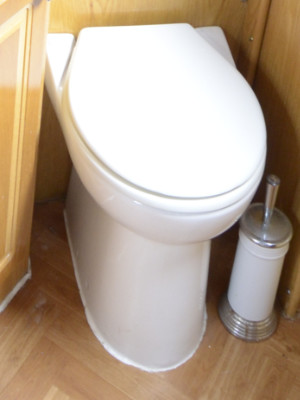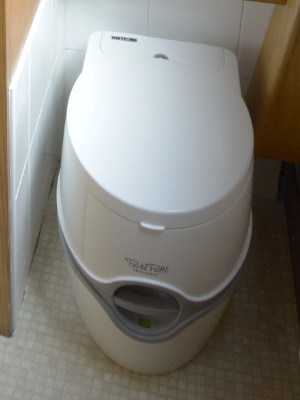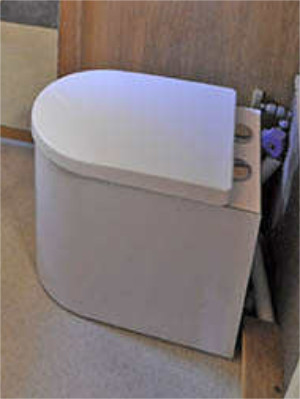Toilet Systems
-
Teach yourself about toilets

Pump-out dump through

Pump-out with remote tank

Cassette (Free-standing)

Cassette (Fitted)

Remote Cassette with vacuum flush

Composting Toilet
There are two main types of wc's used on boats; pump-out & cassette. Composting toilets are seldom found on secondhand boats although they are becoming a more popular choice on new boats.
-
Pump-out dump through
The seat or bowl is directly over the tank and the waste drops into it. These are again divided into 2 main groups, the fresh water flush and the re-circulating flush. The fresh water flush uses water from the boats plumbing system to rinse and flush the bowl. The re-circulating loo uses the liquid in the tank to rinse and flush the bowl (when the tank is emptied up to 10 gallons of clean water is added with the 'blue' to start off the process).
Advantages
- Simple.
- Ceramic bowl.
- The rinse water is part of the boat plumbing.
- Hands free emptying - often done by someone else.
Disadvantages
- Air displaced from the tank when the waste drops in may cause a smell.
- Winter ice or maintenance can prevent boat reaching a pump-out station.
- Tank never clean - often left a long time between emptying.
- The size of the tank varies - may be small.
- Have to empty immediately when full.
- Cost of pump-out £12 to £15 - 2 tanks, 2 charges.
- Expense can be greatly reduced by acquiring a self pump-out kit - many places use a timer for the pump and so may need to pay for 2 units to pump out a large tank.
-
Pump-out remote tank
The waste is pumped, sucked (uses less flush water) or blown to a remote tank - the tank can be any where in the boat to use spare space - but it is best if the tank is balanced across the centre line so that it doesn't affect the trim as it fills up.
Advantages
- No back smells.
- Ceramic bowl.
- The rinse water is part of the boat plumbing.
- Hands free emptying - often done by someone else.
Disadvantages
- Complex machinery - sensitive to what goes down there! - easily blocked.
- Winter ice or maintenance can prevent boat reaching a pump-out station.
- Tank never clean - often left a long time between emptying.
- May use a lot of water with the flush
- The size of the tank varies - may be small.
- Have to empty immediately when full.
- Cost of pump-out £12 to £15 - 2 tanks, 2 charges.
- Expense can be greatly reduced by acquiring a self pump-out kit
-
Cassette (Free-standing)
Free-standing holding tank & seat - the rinse water is held in the 'seat or bowl' fitting.
Advantages
- Simple.
- Normally no cost to empty - when cruising you usually pass an elsan disposal daily.
- When you empty it, it is relatively clean - you can easily empty it every time you leave the boat.
- You can carry a cassette in the winter but not a boat.
- If you have a spare cassette, you can empty the full one at your convenience.
Disadvantages
- A full cassette may be heavy for you to carry.
- Air displaced from the tank when the waste drops in may cause a smell, although never as much as a dump-through tank.
- The rinse water tank has to be filled.
- Looks campingish.
- The seat level may be low.
- Plastic bowl.
-
Cassette (Fitted)
Built-in seat with removable cassette - fixed toilet from which a self-sealing holding tank is extracted, with rinse water from the boat plumbing system.
Advantages
- Same as the free-standing cassette
- But also:
- The unit looks more like a household loo.
- The seat level is at a good height.
- The unit is very stable.
- The rinse water maybe part of the boat plumbing.
Disdvantages
- A full cassette may be heavy for you to carry.
- Air displaced from the tank when the waste drops in may cause a smell, although never as much as a dump-through tank.
- Plastic bowl.
-
Remote Cassette with vacuum flush
Advantages
- No back smells.
- Ceramic bowl.
- Normally no cost to empty - when cruising you usually pass an elsan disposal daily.
- When you empty it, it is relatively clean - you can easily empty it every time you leave the boat.
- You can carry a cassette in the winter but not a boat.
- If you have a spare cassette, you can empty the full one at your convenience.
- The rinse water is part of the boat plumbing.
Disadvantages
- Complex machinery - very sensitive to what goes down there! - easily blocked.
- Cassette size 14L
- A full cassette may be heavy for you to carry.
-
Composting Toilet
Waste breaks down without use of synthetic chemicals or any additives.
Advantages
- A proven concept on land, fairly new to boats.
- Uses no hazardous or environmentally damaging chemicals.
- Solids need to be emptied infrequently.
- Does not require special disposal - compost will produce wonderful tomatoes etc.
Disadvantages
- Waste water compartment requires regular emptying.
- Waste solids compartment needs to be emptied so requires a hands-on approach.
- Waste solids cannot be disposed of in Navigation Authority (e.g. CRT) bins.
- Not very stylish compared to the more common pump-out & cassette types
-
Incinerator Toilet
230V or LPG powered.
Advantages
- No Smells.
- No cost to empty and can be emptied into general waste bin.
- Use no water.
Disadvantages
- Very expensive to purchase (around 3K).
- Use a lot of electric or gas.
- High maintenance/servicing required.
- Not very stylish compared to the more common pump-out & cassette types.
- May use an inbuilt fan and so use more domestic power from batteries.
It has not been permissible for many years on most navigations to use a toilet that pumps untreated waste overboard from what is known as a 'sea-loo'.
